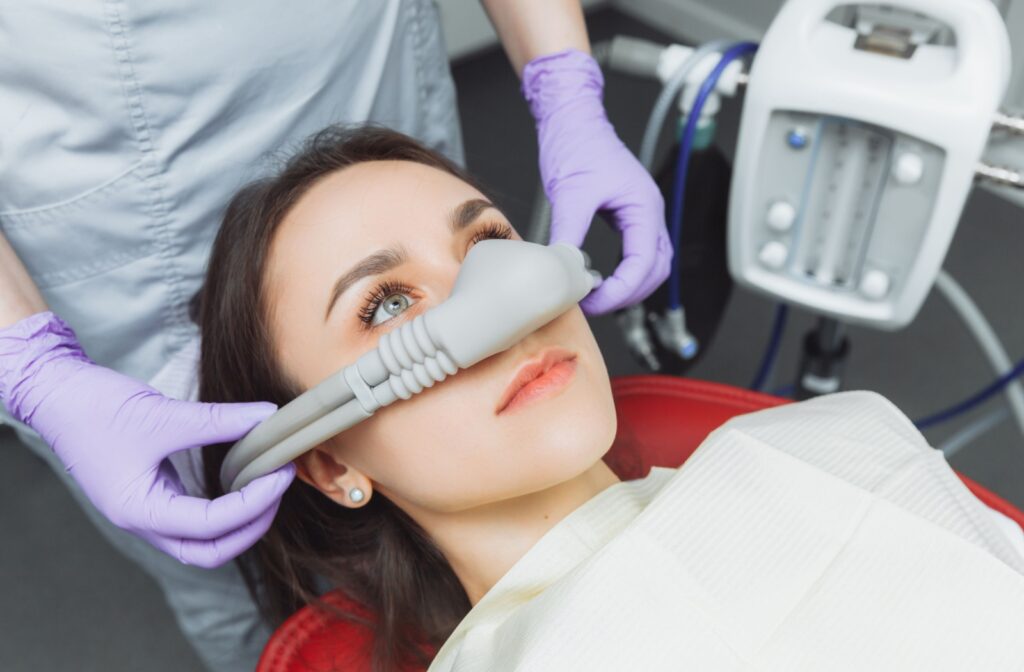Dental visits are crucial for protecting oral health but aren’t always thrilling. Some people experience severe dental anxiety, which may lead to avoiding necessary care.
Sedation dentistry uses mild to moderate sedatives to help reduce anxiety and discomfort, allowing patients to relax during their procedure. Sedation typically makes you drowsy; depending on the type used, the effects can often last from one to several hours.
What Is Sedation Dentistry?
From routine cleanings to more complex treatments, sedation can alleviate anxiety, reduce discomfort, and make the overall experience more comfortable.
Who Is Sedation Dentistry For?
Generally, sedation dentistry is recommended for patients with severe dental anxiety to alleviate their fears and help them receive necessary dental cleanings, exams, and procedures.
You may also be a good candidate if you:
- Need complex dental work done
- Have sensitive teeth
- Have trouble staying still
- Have low pain tolerance
However, sedation dentistry isn’t suitable for everyone. It’s important to consult your dentist to determine whether it’s the right option.
Children who experience anxiety or struggle to sit still may also benefit from sedation. Consult both their pediatrician and dentist to ensure sedation is a safe and appropriate choice for your child.
Are You Aware During Sedation?
There are 4 levels of sedation, and in Alberta, dentists may only provide minimal to moderate sedation. Different levels of sedation may determine different levels of awareness.
Levels of Sedation in Alberta
- Minimal sedation makes you pleasantly drowsy and allows you to relax.
- Moderate sedation makes you a bit more drowsy and forgetful.
Most dental practices can provide minimal sedation, but only select trained dentists can provide moderate sedation. Either way, you’ll still be conscious while sedated, but you may be carefree, drowsy, and forgetful.
Dentists in Alberta are no longer allowed to provide deep sedation or general anesthesia. Deep sedation puts you on the brink of consciousness, while general anesthesia will keep you unconscious for the duration of your procedure. Many dental procedures won’t need this much sedation.
How to Prepare for Dental Sedation
Before your dentist decides you’re a good candidate for sedation, you’ll need to discuss your health history and any medications you’re taking.
Your dentist will give you instructions on how to prepare for your appointment. They may ask you not to eat or drink anything for 6 hours before your procedure, arrange for someone else to drive you home, or avoid certain medications.
What Happens During a Dental Sedation?
Your dentist will give you a sedative and apply a local anesthetic to numb your teeth and gums.
Sedation can be administered in various forms. Your dentist will recommend a specific type of sedation based on the complexity of your procedure and your comfort level.
Inhaled Sedation
Inhaled sedation involves the use of nitrous oxide (laughing gas) and is often chosen for less invasive treatments or procedures that require only light sedation.
Nitrous oxide takes effect within minutes, creating a calming and euphoric feeling. The dentist can adjust the dosage throughout the procedure to maintain the desired level of sedation. It works quickly and wears off quickly, allowing patients to return to regular activity almost immediately after their appointment.
Oral Sedation
Oral sedation involves taking a sedative medication, typically in pill form, about an hour before your dental procedure. The medication is absorbed into your system and takes effect within 30–60 minutes. Depending on the dosage, the level of sedation can range from mild relaxation to a deeper, drowsier state.
While under oral sedation, you’ll likely feel very relaxed and may be drowsy or forgetful after the procedure. You will still be conscious and able to communicate with your dentist, although you might be less aware of the details of the treatment.
IV Sedation
IV sedation is used for patients who require moderate sedation, especially in cases of severe dental anxiety or for longer, more complex procedures. IV sedation delivers the medication directly into your bloodstream through an intravenous (IV) line, allowing precise control over the dosage.
IV sedation takes effect quickly, often within a few minutes. The dentist can adjust the sedation levels throughout the procedure, ensuring you remain comfortable and relaxed. Many patients experience a deep sense of relaxation and may have little to no memory of the procedure later. Although you may occasionally nod off during treatment, you can still wake up easily if needed.
What to Expect After Dental Sedation
Your dentist will monitor you after the procedure until you’re ready to go home. After sedation, it’s normal to feel a bit disoriented. Unless you use laughing gas as your sedative, you will need someone to drive you home. You should rest at home as the sedative medication wears off, which can take one to several hours, depending on the sedative.
Your dentist will provide care instructions to help the recovery process based on your dental procedure.
Sedation Dentistry in Calgary
Dental procedures are necessary to maintain oral and overall health. Sedation dentistry can help reduce dental anxiety and help people receive necessary care.At Shawnessy Dental Centre, we prioritize your comfort and well-being and help you smile healthily and confidently with tailored care and professional guidance. Contact us today to discuss your sedation options.


